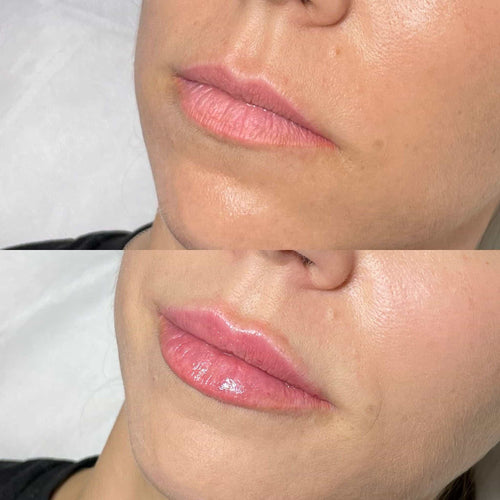Get to Know Dermal Filler Treatments at It’s Me and You Clinic
New Patient Treatment Options
General Practitioners
Contact Dr. Laura Geige to Explore Anti-Wrinkle Treatment Options
Finding a new General Practitioner (GP) near Betchworth, Surrey can be an important step in managing your health and wellbeing.

When considering treatment options with a new GP, remember that they provide a wide range of services for all ages.
These services include:
-
Routine Checkups: Regular checkups are essential for preventative care and early detection of potential health issues.
-
Management of Chronic Conditions: GPs can help manage long-term conditions such as diabetes, asthma, and heart disease through monitoring, medication management, and lifestyle advice.
-
Treatment of Acute Illnesses: If you’re feeling unwell, your GP can diagnose and treat a variety of illnesses like colds, flu, infections, and minor injuries.
-
Health Screening and Vaccinations: GPs offer screening for various health conditions and administer vaccinations to protect against diseases.
-
Mental Health Support: Many GP practices offer support for common mental health concerns. They can provide counselling, referrals to specialists, and medication management.
-
Family Planning and Sexual Health Advice: GPs can provide advice and services related to contraception, sexual health, and family planning.
Get in Touch with Dr. Laura Geige at It’s Me and You Clinic Immediately
Finding a GP who is a good fit for you is crucial. Consider factors like:
-
Location and Accessibility: Choose a practice conveniently located and with convenient opening hours.
-
GP Personality and Communication Style: It’s important to feel comfortable and understood by your GP.
-
Practice Philosophy and Services Offered: Some practices may specialize in certain areas, so choose one that aligns with your needs.
To find a GP near Betchworth, Surrey, you can:
-
Use the NHS website’s online GP finder tool:
-
Ask for recommendations from friends or family.
-
Check local directories and health service listings.
- Dental Clinics: Betchworth has several dental clinics offering general dentistry, cosmetic procedures, and orthodontics.
- Opticians: Find eye examinations, glasses, and contact lenses at local opticians.
- Physiotherapy Clinics: Address musculoskeletal issues with personalized treatment plans.
- Mental Health Services: Seek counseling or therapy for emotional wellbeing from therapists and psychologists.
- Surrey and Sussex Healthcare NHS Trust:** This trust operates hospitals in Epsom and St Helier, providing a range of inpatient and outpatient services.
- NHS Choices: Search for GPs, dentists, pharmacies, and other NHS services near you.
- Private Healthcare Provider Websites:** Explore options for private treatment.
-
General Practitioners (GPs):
-
Surrey & Borders Partnership NHS Foundation Trust (SABP):
-
Community Mental Health Teams (CMHTs) offer support for various conditions, such as depression, anxiety, and psychosis.
-
IAPT (Improving Access to Psychological Therapies) provides therapy services like Cognitive Behavioral Therapy (CBT).
-
Crisis Resolution Teams are available 24/7 for individuals experiencing mental health crises.
-
Private Therapists and Clinics:**
-
Specialized Services:
-
Services for children and adolescents (e.g., CAMHS – Child and Adolescent Mental Health Services).
-
Addiction services.
-
Eating disorder treatment centers.
- **Sports Injury Rehabilitation:** Tailored programs designed to assist athletes in recovering from sports-related injuries, optimizing performance, and minimizing the risk of re-injury.
- **Neurological Rehabilitation:** Specialized therapies for patients recovering from stroke, traumatic brain injury, or other neurological conditions, focusing on regaining motor function, balance, and cognitive abilities.
- **Pain Management:** A multidisciplinary approach utilizing manual therapy, exercise prescription, and education to alleviate chronic pain and improve quality of life.
- **Postural Correction:** Assessment and treatment plans to address postural imbalances, promoting spinal alignment and reducing strain on muscles and joints.
- **Individualized Exercise Programs:** Designed to meet the specific needs and goals of each patient, promoting functional strength, flexibility, and endurance.
- **Occupational Therapy:** Assistance with regaining independence in daily living activities, such as dressing, bathing, and cooking.
- **Speech Therapy:** Treatment for communication and swallowing disorders that may arise after neurological injury or surgery.
Dental Care
For new patients seeking dental care near Betchworth, Surrey, there’s a wide range of treatment options available to address various needs.
Comprehensive examinations are typically the first step, involving a thorough review of your oral health history, a visual inspection, and possibly X-rays.
Based on the findings, your dentist can recommend personalized treatment plans. Common treatments for new patients include:
**Preventive Care:**
This is essential for maintaining long-term oral health.
It involves regular cleanings to remove plaque and tartar, fluoride treatments to strengthen enamel, and dental sealants on children’s molars to prevent cavities.
**Restorative Care:**
If you have existing dental problems, restorative procedures may be necessary. These include:
• **Fillings:** Replacing decayed tooth structure with composite or amalgam material.
• **Crowns:** Covering damaged teeth to restore their shape, size, and strength.
• **Bridges:** Replacing missing teeth by anchoring artificial teeth to adjacent healthy teeth.
• **Root Canals:** Saving a severely infected or damaged tooth by removing the pulp (soft tissue inside the tooth) and filling the canal system.
**Cosmetic Care:**
For those seeking to enhance their smile, cosmetic dentistry options include:
• **Teeth Whitening:** Brightening teeth using professional-strength bleaching agents.
• **Veneers:** Thin porcelain shells bonded to the front of teeth to improve appearance.
• **Inlays and Onlays:** Custom-made restorations that cover a portion of a tooth, offering a more conservative alternative to crowns.
Finding a new dentist near Betchworth requires research. Consider factors like experience, specialization, patient reviews, insurance coverage, and office location. Online directories and local recommendations can be helpful resources.
Other Healthcare Providers
New patients seeking treatment options near Betchworth, Surrey have a range of choices depending on their specific needs.
General Practitioners (GPs)
GPs are the first point of contact for most healthcare needs. They provide routine check-ups, diagnose and treat common illnesses, and refer patients to specialists when necessary.
To find a GP near Betchworth, you can use online directories such as NHS Choices or by asking for recommendations from friends and family.
Specialist Clinics
For specific conditions or concerns, there are various specialist clinics in the area:
Hospitals & Urgent Care**
For serious medical emergencies, call 999. In less urgent situations, visit an NHS walk-in centre or minor injuries unit:
**Finding Healthcare Providers Online**
Utilize online resources for convenient access to information:
Remember to check opening hours, appointment availability, and insurance coverage before visiting any healthcare provider.
Understanding Access to Care in Betchworth
NHS Services
Access to healthcare is a fundamental right and a crucial aspect of overall well-being. Understanding access to care in Betchworth, particularly within the NHS framework, is essential for residents seeking medical treatment.
Betchworth falls under the jurisdiction of the Surrey Heartlands Integrated Care System (ICS), which oversees healthcare delivery across a wide geographical area. The ICS comprises various NHS providers, including hospitals, GP practices, community health services, and mental health services.
For routine medical care, residents of Betchworth typically register with their local General Practitioner (GP) practice. These practices act as the primary point of contact for most healthcare needs, providing a wide range of services such as check-ups, vaccinations, chronic disease management, and referrals to specialists when necessary.
The closest acute hospital to Betchworth is likely Surrey and Sussex Healthcare NHS Trust, which operates hospitals in Crawley and East Grinstead. This trust provides a range of emergency and planned care services, including accident and emergency, surgery, maternity care, and paediatrics.
Beyond acute hospital services, the ICS offers a variety of specialized community-based healthcare services. These might include physiotherapy, occupational therapy, speech and language therapy, mental health support, and palliative care.
Access to these services can vary depending on individual needs and availability. Waiting times for non-urgent appointments may apply, particularly for specialist consultations or elective procedures.
To find specific GP practices and NHS healthcare facilities near Betchworth, residents can use online resources such as the NHS website, which provides a searchable directory of providers.
Private Healthcare Options
Betchworth, a village nestled in the heart of Surrey, offers a range of healthcare options for its residents. While the NHS provides a foundation of public healthcare, many individuals seek private healthcare alternatives due to factors like quicker access, specialized services, and personalized care.
Private healthcare options in and around Betchworth cater to various needs. Reputable private hospitals such as Nuffield Health and Spire Healthcare operate clinics within reasonable distance, offering comprehensive medical services including diagnostics, surgery, and outpatient consultations.
For specific treatments or specialists, patients may consider consulting with private practitioners. Betchworth and its neighboring towns have a network of GPs, dentists, physiotherapists, and other healthcare professionals who offer private appointments. These practitioners often provide more flexible scheduling options and personalized attention.
Accessing private healthcare in Betchworth typically involves several steps. Firstly, it’s important to research different providers, compare their services, expertise, and fees. Online directories and patient reviews can be helpful resources. Once a suitable provider is identified, patients can contact them directly to inquire about appointments, costs, and insurance coverage.
Private health insurance plays a significant role in facilitating access to private healthcare for many individuals. Several insurance providers offer comprehensive plans that cover various medical services, including consultations with specialists, hospital stays, and diagnostic tests. Choosing the right insurance plan depends on individual needs and budget.
Understanding the different private healthcare options available near Betchworth empowers residents to make informed decisions about their health and well-being. By researching providers, exploring insurance options, and considering personal needs, individuals can navigate the private healthcare landscape effectively.
Specialized Treatments Available Near Betchworth
Mental Health Support
Finding specialized mental health treatment near Betchworth can be a crucial step towards improving your well-being. Surrey offers a range of services tailored to various needs.
Here are some resources and types of treatment available in the area:
Your local GP is an excellent starting point. They can offer initial assessments, provide counseling, and refer you to specialized services if needed.
This NHS trust provides a wide range of mental health services across Surrey and borders. These include:
Betchworth and surrounding areas have several private therapists specializing in various therapies, including CBT, psychodynamic therapy, and mindfulness-based approaches. Private clinics often offer a wider range of specialized services.
Depending on your specific needs, you might consider:
Remember to consult with your GP or a trusted healthcare professional for personalized guidance on finding the most suitable mental health support near Betchworth.
Physiotherapy and Rehabilitation Services
Nestled amidst the picturesque Surrey countryside, Betchworth offers a range of specialized treatment options for new patients seeking physiotherapy and rehabilitation services.
One prominent provider in the area is _**Name of Physiotherapy Clinic**,_ renowned for its team of experienced physiotherapists who employ evidence-based practices to address a wide spectrum of musculoskeletal conditions.
Their comprehensive services encompass:
Another reputable option is _**Name of Rehabilitation Center**_, which specializes in comprehensive rehabilitation programs following surgery or illness. They offer a holistic approach encompassing:
For patients seeking specialized treatment options, Betchworth provides access to a network of highly qualified physiotherapists and rehabilitation professionals dedicated to helping individuals achieve optimal recovery and well-being.
Emily Patricia Fae James Martin Live Bend and Blossom My Better Love Prince and Flower


